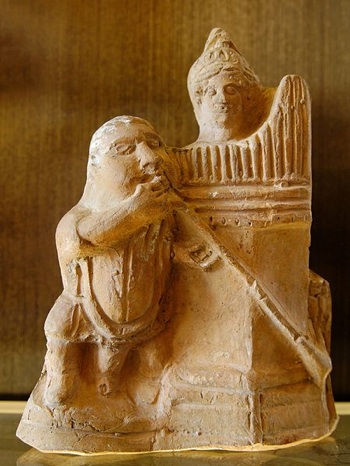A magazine where the digital world meets the real world.
On the web
- Home
- Browse by date
- Browse by topic
- Enter the maze
- Follow our blog
- Follow us on Twitter
- Resources for teachers
- Subscribe
In print
What is cs4fn?
- About us
- Contact us
- Partners
- Privacy and cookies
- Copyright and contributions
- Links to other fun sites
- Complete our questionnaire, give us feedback
Search:
Classical music. No, really classical

In ancient Greece, there was a musical instrument called the epigonion. No one makes them any more – in fact they haven’t existed for two thousand years. It looked sort of like a harp, and had a bright, metallic sound when the player plucked its strings. That information about the sound didn’t come from looking it up in a book, it came from listening to an epigonion. How could you hear the sound of a musical instrument that no one on Earth has laid eyes on for millennia? Thanks to computer modelling.
Finding lost sounds
Researchers and musicians at the Conservatory of Music of Parma, in Italy, have been working on ways of resurrecting the lost sounds of ancient musical instruments. What they do amounts to recreating the instrument in physics equations, then playing it through a computer simulation.
First they need to find out what the instruments themselves were like. Fortunately, the researchers can rely on archaeological sources like writing, fragments of the instruments from excavations, and even pictures on ancient urns. Once they’ve got a good idea what an instrument looked like and what it was made from, they can get down to the business of making it come alive again.

They’ve really thought of everything
The idea is to find out how every different part of an instrument would behave, to build a complete model of it inside a computer. For example, if they were modelling a drum, they would start by finding an equation for the way that hitting the two-dimensional skin on top makes it vibrate. Then they need to figure out how all the different qualities of the skin – its mass, its density, its stiffness and everything else – combine with everything about the body of the drum. Plug all of that into the model, then add some energy. In other words, try and play it. If you’ve done your model right, you will get information out that that tells you how the drum would sound.
If that sounds like a lot of stuff to think about, you’re right. It takes so much power to crunch all of that physics that the researchers spread the job around what’s called a grid. That’s a huge collection of computers, designed to work together to share their computing power. In this case, they’re using a grid that stretches all around the Mediterranean. Having grid computing to help out is an awfully handy thing – if they were using just one high-powered computer, it would take about four hours to get just 30 seconds of ancient sound.
The best salpinx players in the world
Should you think that the team in Parma are going to all this trouble just for some strange number crunching pleasure, don’t worry. They perform with the instruments too. Remember I said I’d heard the sound of an epigonion? That’s because they’ve started an orchestra. The Lost Sounds Orchestra, billed as ‘an ensemble from the past’, is the first ensemble in the world that only play reconstructed lost instruments. With an exotic list of instruments like the epigonion, chitara, salpinx and aulos, they can guarantee to offer a sound that no one has heard before. No one living since the days of togas and philosophising, anyway.


